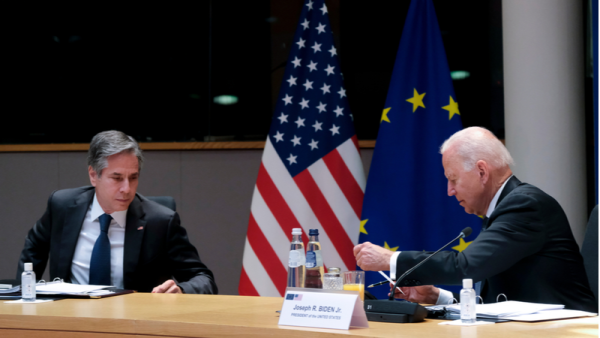No evidence the US has Australia’s back in its dispute with China, despite all the rhetoric
Alexandros Michailidis / Shutterstock

James Laurenceson, Director, Australia-China Relations Institute, University of Technology Sydney |
This article appeared in the South China Morning Post on July 23 2021.
The US has ‘got our back’. This talking point is repeated by Australian government ministers with rising fervour, as China continues its campaign of trade punishment against Australia. Think-tank experts and media commentators amplify it further.
Knowing the acute Australian desire for reassurance, American officials and diplomats are only too happy to oblige, while also encouraging Canberra not to back away from the increasingly adversarial stance it has taken towards Beijing.
In March, Mike Goldman, the US chargé d’affaires – Canberra has been without an American ambassador for 36 of the last 58 months – cheered Australia on: ‘I’d just say keep on doing what you’re doing but with confidence that the United States and other like-minded democracies see an interest in having Australia succeed.’
In May, US Secretary of State Antony Blinken even borrowed a cricketing metaphor, insisting that Australia would not be left ‘alone on the pitch’.
Yet nearly 200 days into the Biden administration, there’s still no evidence that US support extends beyond rhetoric.
This isn’t to deflect attention away from behaviour by Beijing that is poisonous to constructive bilateral relations. But Australian state governments, the business community and general public deserve to know who is bearing the costs.
Australia’s security ally certainly has the capacity to deliver significant practical support – if it was inclined to do so.
The US could start by spelling out how it was delivering on a promise made in March by President Joe Biden’s ‘Asia tsar’, Kurt Campbell. He said the US was ‘not prepared to improve relations’ with China at the same time Australia was being hit with trade attacks.
Two months later, however, Blinken walked this back, revealing he had told Chinese officials that it would only ‘hinder’ improvements in relations if Beijing didn’t let up.
Biden’s national security adviser, Jake Sullivan, announced in June that a meeting between the US president and Chinese President Xi Jinping, was ‘now just a question of when and how’. That Xi doesn’t pick up the phone when Australian Prime Minister Scott Morrison calls won’t stop Biden taking a face-to-face opportunity to press his country’s interests.
Second, the US could cease blocking the appointment of new judges to the World Trade Organization’s appeals body.
This decade-long practice finally rendered the WTO’s dispute resolution capacity defunct in 2020. In the process, it dealt a blow to Australia’s ability use global trade rules to defend itself against Chinese attacks.
In May, the US rejected a proposal from Australia and around 80 other countries that would have brought the body back to life as deeper WTO reforms were being thrashed out.
Third, the Biden administration could voluntarily rescind the bilateral trade pact the Trump administration coerced China into signing in January 2020.
By mandating that China must buy more energy and agricultural goods from US producers, the pact put Australian miners and farmers at an unfair disadvantage.
The US’ strong-arm negotiating tactics also confirmed in Beijing’s mind that WTO rules and principles were optional for great powers.
Yet, far from rescinding the pact, Biden’s trade chief, Katherine Tai, insisted in February that China ‘needs to deliver’ on it.
Fourth, the US could embrace the Trans-Pacific Partnership trade deal it championed once upon a time.
This would demonstrate to Australia and other countries in the region that it is seriously committed to a ‘free and open Indo-Pacific’, not just for its aircraft carriers, fighter jets and spy vessels.
US membership would also support Australia’s desire for greater trade diversification.
But, at the beginning of July, the Biden administration allowed its Trade Promotion Authority to lapse, making the task of getting any complex trade deals through Congress in the foreseeable future next to impossible.
Fifth, the US government could at least publicly shame, if not stop, American companies that swoop in on the lucrative markets in China that Australian suppliers have been forced to surrender.
Alas, while there’s been no hint of such action, what is known is that the US share of China’s massive imported coal market, worth US$20 billion plus a year, has increased significantly.
It has gone from nothing in September 2020 – a month before China locked out Australian coal – to 7.9 per cent now. Meanwhile, Australia’s share has gone from 42 per cent to zero. The same pattern is seen for beef and more.
Finally, the US government could pull out all the stops to promote more American purchases of the Australian goods that China is blocking.
The damp squib delivered has been outgoing officials like Trump’s secretary of state, Mike Pompeo, taking to social media to proclaim their new-found love for vintages from the Barossa Valley and Margaret River.
Trade data shows that, in the quarter to October 2020 – a month before China imposed massive anti-dumping tariffs on Australian wine – US imports of Australian alcoholic beverages were worth A$124.8 million (US$91.98 million). In the quarter to May 2021, this had fallen to A$102.1 million.
Talk is cheap. These actions that would support Australia involve a cost – either to the US economy or political capital in Washington. That none have been taken is instructive. Australia remains on its own.
Author
Professor James Laurenceson is Director of the Australia-China Relations Institute at the University of Technology Sydney.

